
Is pgsharp legal when you are playing pokemon On Vivo X Fold 2? | Dr.fone

Is pgsharp legal when you are playing pokemon On Vivo X Fold 2?
Pokémon Go is the phenomenon that hit us in 2016 and made us obsessed with the AR game based on real-time location. If you are one of those players who have been to all the local PokeStops in hopes of finding your favorite rare Pokémon, then it might be time for you to consider spoofing your location while playing PoGo.
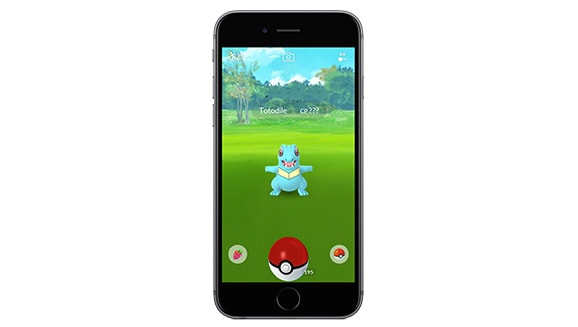
Pokémon Go relies on GPS coordinates and real-time tracking to let players catch Pokémon s in real locations. Hence, spoofing comes to the discussion of “catching them all.”
‘Spoofing’ location makes your phone, and thereby the game thinks that you’re in another location, which opens up the possibility to catch new and rare Pokémon s from gyms and PokeStops around the world.
Part 1: Is Pgsharp legal?

No game developer likes to see their game played in unfair ways. Thus, Niantic (PoGo’s Dev) made some strict rules against exploiting their game, giving some players an unfair advantage over others.
So, is PGSharp legal? No, Spoofing location, in general, is illegal. Hence, any apps like PGSharp, or Fake GPS Go, used to disguise actual real-time location and fake it, will result in an account ban.
According to Niantic’s terms and conditions:
- “Using any techniques to alter or falsify a device’s location (for example through GPS spoofing).
- And _”_Accessing Services in an unauthorized manner (including using modified or unofficial third party software).”
If Niantic detects usage of a fake location or GPS spoofing app while playing Pokémon Go, they will impose a strike on your account.
- The first strike would make rare Pokémon s not visible to you for seven days.
- The second strike would temporarily ban you from playing the game for 30 Days.
- The third strike will permanently ban your account.
You can appeal these strikes to Niantic if you think you’ve been banned without violation of any terms.

Part 2: Three ways to spoof on Android
- PGSharp :

PGSharp is one of the most reliable ways to spoof your location while playing Pokémon Go. Niantic does not easily recognize its simple map-like UI as a fake location app.
Note: It is recommended not to use your main account while spoofing; rather, you should use your PTC (Pokémon Trainer Club) account.
- To spoof the location with PGSharp, go to Google’s “Play store,” search “PGSharp,” and install it.
- After installation, there are two versions: Free and Paid. For trying the app with the free version, a beta key is not required anymore, while for the paid version, a key from the developer is required.
- For the paid key, visit PGSharp’s official website and generate a license key.
You must note that it may take two or more tries to generate a working key, and often it may show an “out of stock.” message.
- After opening the app and applying the key, you can spoof the location with ease.
Note: You may need to allow “Mock location” from debugging options. For this, go to “Settings,” then to “About Phone,” then you need to tap on “Build number” seven times to enable developer’s mode, and finally go to “Debugging” to allow “Mock location.”
- Fake GPS Go:
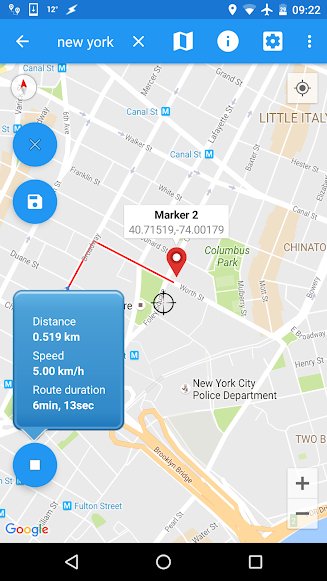
Fake GPS Go is another location spoofer app for Android that is reliable and free. This app allows you to fake your real-time location and enables you to spoof it to any place in the world. This is one of the easiest solutions to playing Pokémon Go while spoofing location without getting detected with its real-map-like UI. Moreover, this app does not even require root access.
- To install Fake GPS Go, go to Google’s “Play store,” search “Fake GPS Go,” and install it.
- Then, go to your phone’s “Settings” and then “System” followed by “About Phone,” and tap on the “Build Number” 7 times to enable the Developer Options.
- Then you need to go to “Debugging” in “Developers Options” to allow “Mock location.”
- And then, you can use this app to not only spoof your location but virtually walk around a route at a designated pace to make it look as real as possible for being undetected by developers like Niantic.
- VPN:

Using a Virtual Private Network (VPN) App is the safest option to spoof your location while playing PoGo, as it masks your IP address and uses a server in any other location.
Moreover, some VPNs would also encrypt your data, so it would not be easy for Game Devs to track it.
- To install a VPN, go to Google’s “Play store,” search the VPN of your choice and install it.
- Close the Pokémon Go app from running in the background to prevent detection of the VPN.
- Now, select a location server to any place before opening the PoGo app again.
Note: Some Free VPNs only mask your IP address and do not spoof your location, nor do they encrypt your data. Hence, selecting a good VPN app is imperative, which will spoof GPS location and data encryption.
You can use both VPNs (which do not spoof GPS location themselves) and the Fake location app simultaneously for extra reliability.
Part 3: Best way to spoof on iOS – dr.fone Virtual Location
Spoofing the GPS location on iPhones is more difficult and much more complex than it is on Android. However, there is a solution. Dr.Fone comes to the rescue with their Virtual Location tool that works seamlessly. This program is easy to use and allows you to simulate your location between 2 and multiple spots with ease. Apart from that you can teleport anywhere with ease. Let us know how this tool works.
Step 1: Download the tool on your PC from the official website of drfone. Select “Virtual Location” given on the first page of the program.

Step 2: Now, have your iPhone connected to your computer. Then select “Get Started”. Now a map will open in a new window, showing your actual location.
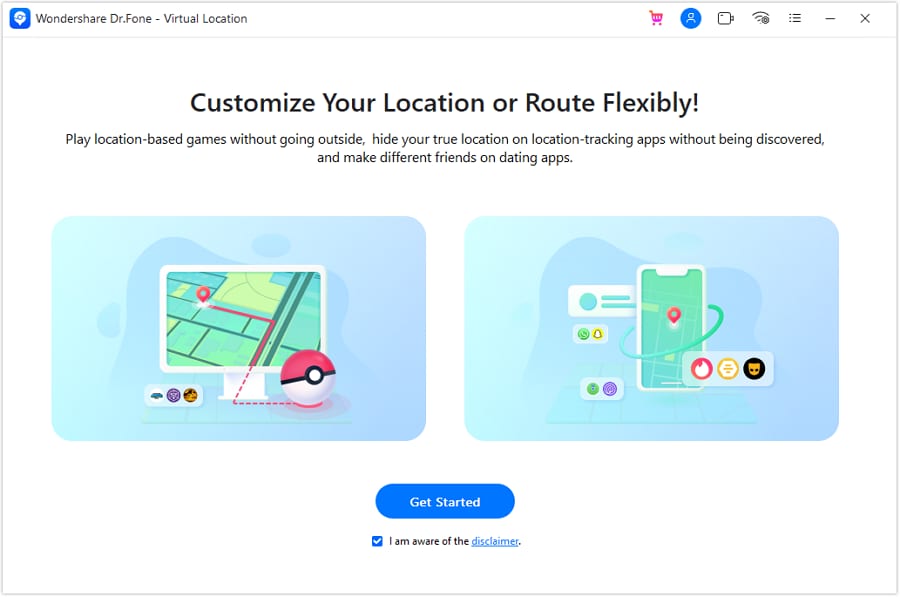
Step 3: Enable the “teleport mode” by the third icon in the right-upper corner of the map. Then, enter the location you want to spoof your phone’s GPS to in the text box in the map’s left-upper section. Select “Go”.
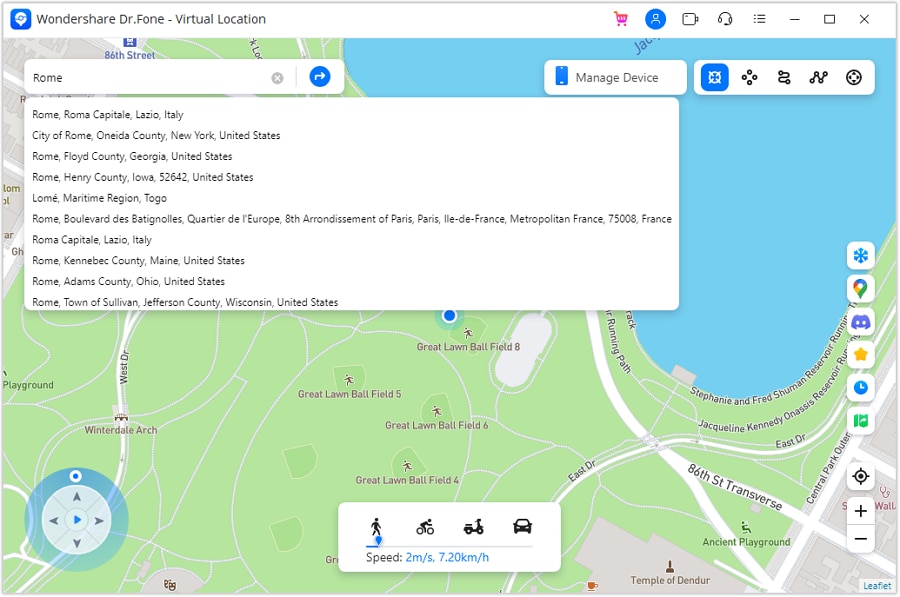
Step 4: Now select “Move here.” And you will have successfully spoofed your location on your iOS device. To confirm, open the maps app on your device.
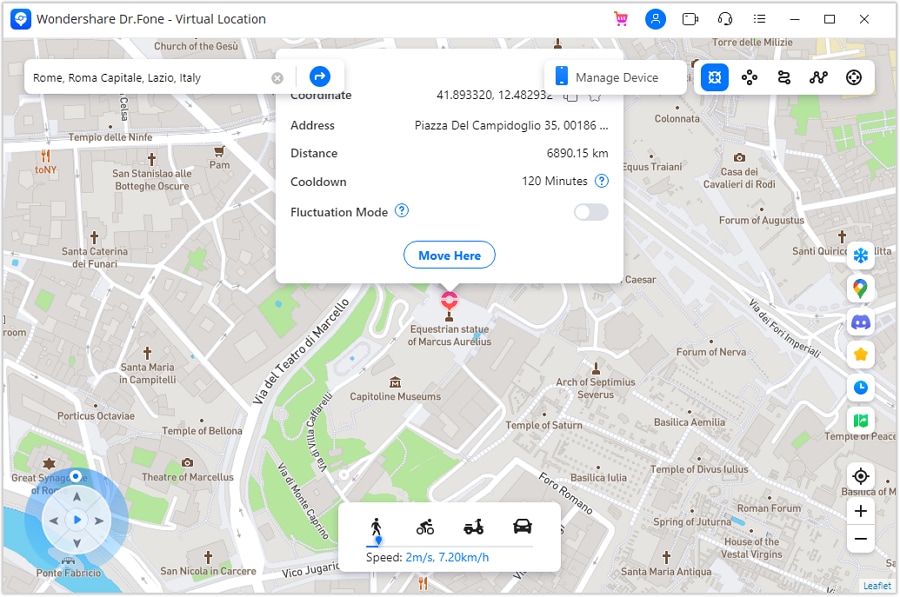
Pro-Tips:
- Do not spoof or change location very frequently, as this might raise suspicion to the Game Dev (Niantic), and the account may get terminated, stating violation of terms.
- Do not use spoofing too frequently. The best way to not get your account suspended is to replicate actual travel patterns.
- Please select a new spoof location and scout it for a couple of days before going to a close-by spoof location. After you are done with the country in the spoof-location, you can move on to neighboring countries before returning to your original location (i.e., switching off the spoof.)
- After you are done with your gaming, always remember to close the game from the background before turning off the spoof location.
- Do not always play with the spoof location. Play with your original location for a couple of weeks before spoofing your location.
- Do not spoof location to countries on different continents within a short time.
Following these tips will help you to behave like an actual traveler who’s on a Pokémon hunt. This will make it even harder for game devs to detect any discrepancies.
How to Stop Google Chrome from Tracking Your Location On Vivo X Fold 2?
Do you know your web browser is continually sharing your actual location online? You might not have noticed, but the number of websites using your location has increased. As you are well aware of the dangers of the internet, it doesn’t make sense to turn your Chrome into a beacon for ill-intentioned people. Luckily, it is possible to fake a location on Chrome with the right tool.
Are you wondering how to fake the browser location or which tool to use? You can get all your answers by reading this article till the end.

Part 1: How Does Chrome Know Your Location?
Before discussing Google Chrome’s fake location, it is important to know how Chrome detects your physical location. Google Chrome uses many ways to pinpoint your exact location, like your IP address, GPS, Wi-Fi, Bluetooth, and Cell Tower data. Every internet connection has an IP address bound to a location that enables Chrome to identify your location.
Similarly, GPS location can easily be tracked if your phone device has it enabled. All the Wi-Fi and Bluetooth connections around you also have location information embedded in them. They can help Chrome track you as long as your device can detect them. If you use cell data, Google Chrome can also track you through cell towers.
Part 2: How to Hide Location Services in Chrome?
If you are worried about Google Chrome detecting your physical location and sharing it with websites and apps, you can hide it easily. The process of hiding your location on Google Chrome is simple, even if you are using multiple devices. Below is the step-by-step process of hiding location services in Google Chrome on computer, Android, and iOS devices.
Method 1: For Laptop and Desktop PCs
Step 1: Launch Google Chrome on your computer and click the “Three Dots” icon to open the Google Chrome Settings. Here, tap “Privacy and Security” from the left sidebar and select “Site Settings.”

Step 2: Navigate to “Permissions” and click on “Location.” To hide the location on Google Chrome, select the “Don’t allow sites to see your location” option.

Method 2: For iPhone or iPad
Step 1: Navigate to “Settings” on your iPhone and open it. Scroll down until you find the “Chrome” app option and select it.

Step 2: Press “Location” on the next screen to open the location options for Google Chrome. Here, choose “Never” to stop Google Chrome from detecting your location.

Method 3: For Android
Step 1: Open Google Chrome on your Vivo X Fold 2, press the “Three-Dots” icon, and tap “Settings” from the options.

Step 2: In Chrome Settings, press “Site Settings.” Now select “Location” and hide your location by toggling off the “Location” option.
 TubeDigger - online video downloader from mostly any site
TubeDigger - online video downloader from mostly any site

One way to protect your privacy and stop websites from tracking your location is to turn off the location, but it has many disadvantages. If you have turned off your location, you can’t use any location base service like food delivery, e-shopping, ride-sharing, etc. That’s why it is better to use a fake location on your browser. Below we have explained four methods for Chrome fake location.
Method 1. Best Tool to Fake Chrome Location On iOS and Android Phones
The easiest and quickest way to fake your location on Google Chrome is to use Dr.Fone - Virtual Location . Since smartphones contain a wide range of apps that require location access, it provides a stable way to fake Chrome locations on Android and iOS phones. No website or app will be able to detect that you are using a fake location when using Dr.Fone - Virtual Location for faking GPS location.
Key Features
- Dr.Fone - Virtual Location can be used for any social media app like Facebook, Twitter, or Instagram with a fake location.
- With the help of this tool, you can also spoof real-time tracking apps like Life360 to protect your privacy.
- If you are an iPhone user, you don’t have to jailbreak your iPhone to spoof your device’s location.
How to Fake Chrome Location On iOS/Android Phones via Dr.Fone - Virtual Location
Faking your Chrome location with Dr.Fone - Virtual Location is very straightforward. You only need the Dr.Fone mobile toolkit and a USB cable to connect your Vivo X Fold 2. Follow these steps to spoof Chrome location on Android and iOS phones:
Step 1: Connect Your Android/iOS Device to Your Computer
Connect your Android or iOS phone to your computer using a USB cable. Launch the Dr.Fone robust toolkit on your computer and select “Virtual Location.”

Step 2: Activate the Teleport Mode
Press “Get Started” on the next page to open the map window. First, select your actual location by pressing the “Center On” icon from the right sidebar. Afterward, click on the “Teleport” icon from the top right corner to activate the Teleport Mode.
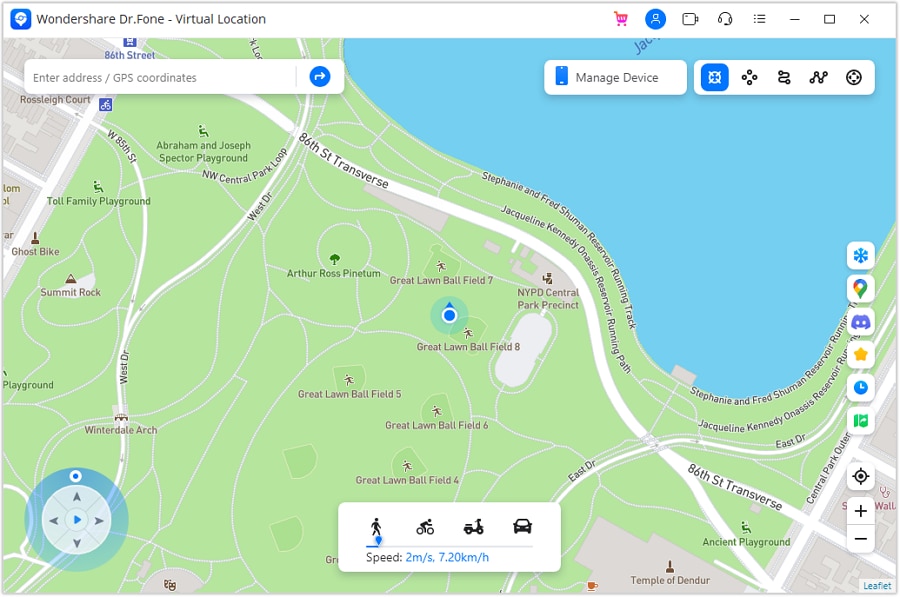
Step 3: Add the Desired Fake Location
Once the Teleport Mode is activated, add your desired location and press “Go.” Your desired location will open on the map. Select it, and a pop-up window will appear where you need to press “Move Here.” With that, your Android or iPhone’s Chrome location has been changed.

Method 2. Manually Change Your Location Using Google Chrome DevTools
It is also possible to fake browser location on Chrome using the Google Chrome Developer Tools. It is a built-in feature of Chrome and can be used to manually change or turn off your browser’s location. Follow these steps for changing location on Chrome with DevTools:
Step 1: After opening Google Chrome, click the three-dots icon from the top right corner. It will open the Chrome menu where you need to select “Developer Tools” after clicking “More Tools.”

Step 2: A window will open on the right side with all the developing tools you can use in Chrome. Click on the three-dots icon located near “Console” in the bottom left corner of the window. Choose “Sensors” from the pop-up menu.

Step 3: Access the newly selected “Sensor” option, and here you can change the browser’s location by either selecting a Google’s pre-set location or adding your desired location manually. Once the location is selected or added, your browser’s location will change.

Limitations
- The interface of the Google Chrome DevTools can be very confusing and overwhelming for non-technical users.
- Apart from pre-added locations, it can be hard to add a specific location as your fake location.
Many fake location Chrome extensions are available on Google Chrome which can be used to alter your location on Chrome. You can find these extensions on Google Chrome Web Store and add them directly to your browser. Below we have explained the steps for using such an extension “Location Guard “ to fake your location on Google Chrome:
Step 1: Open the “Location Guard” on Chrome Web Store and click “Add to Chrome” to add it to your browser. Once the “Location Guard” extension is added, open it and press “Options.”

Step 2: In the options, you can choose different options like Privacy Levels, Protection Area, and Time for Location Cache. It is recommended you choose a higher level for more protection.

Step 3: You can also use the “Fixed Location” feature to set up a fake location as a permanent location for your browser. The fixed location can be added by using the market or clicking on the desired place on the map.
Limitations
- Location Guard doesn’t protect your IP address. It means some websites can still detect your real location using the IP address.
- The app is not updated for quite a while, that’s why the map of the fixed location feature is quite restricted.
Method 4. Spoof Your IP Using a VPN Server
Another way you can fool websites and your browser by displaying a fake location online is to use a VPN server. VPNs fake your IP address to fool websites and apps into detecting your location. NordVPN is a VPN that can be used to spoof your IP by following these steps:
Step 1: Download and install NordVPN on your computer or phone and log in using your account. If you don’t have a NordVPN account, you must create one first.
Step 2: If you want to just change the location of your device, you can select “Quick Connect.” Using it will enable the program to automatically find the most suited fake location for you.

Step 3: You can also choose the desired location as your fake Chrome location in NordVPN. To do that, scroll down the list of countries and locations and choose your desired locations to connect to.
Limitations
- NordVPN can only spoof your IP address and will not work for geo-restricted applications.
- Using a VPN usually affects your internet speed and can make browsing slower and more difficult.
Part 4: FAQs
1.What is Geolocation?
Geolocation is a term used for the process of pinpointing the location of a device connected to the internet. The location can be determined using methods like IP address, GPS, and mobile tower data. Apps and websites commonly use it to provide location-based services.
2.What is the HTML5 Geolocation API?
The HTML5 Geolocation API is a browser API used to determine a user’s geographical location. Developers use it to build location-aware websites and apps that use users’ locations as the basis for providing their services. It can detect location through GPS, Wi-Fi, Bluetooth, IP addresses, etc.
3.Why should you hide or spoof your Location?
Hiding or spoofing your location protects your privacy and stop application and websites from tracking you. It also allows you to access geo-restricted apps and play location-based games. You can also fake your location to get the latest updates of your favorite apps.
Conclusion
The fact that Google Chrome in your devices can track your location with an accuracy of up to 20 meters is very unsettling for users. Even when you try to be careful in granting location permissions to apps and websites, many can still bypass this by adding location access requirements in terms and conditions.
That’s why having a tool like Dr.Fone - Virtual Location to fake GPS online is essential nowadays. It can ensure your privacy and helps in protecting you from the dangers of the internet.
11 Best Location Changers for Vivo X Fold 2
Nowadays, smartphone users rely on GPS to get from one location to another. Even cab services can’t complete a single trip without using maps in this technological age. So GPS has now become an integral part of everyone’s lives. When you download certain apps, you’ll notice that they request location permission. But most smartphone owners are unaware of the location-changing/spoofing feature they can enable on their devices. Yes, you read that correctly.
You can genuinely spoof your device’s location. While spoofing your location, the applications on Your Vivo X Fold 2 will believe you are in your selected location when you are actually in a different area. Isn’t it incredible? With the top 11 best location changers, you can easily accomplish this.
You can use the GPS location changer app for iPhone and Android devices to assist you. In addition, specific tools will enable you to use a custom location according to your needs. So let’s quickly learn about them.
 Nero Burning ROM:
Nero Burning ROM:
The ultimate burning program for all your needs!
Top 1 location changer for iOS and Android
Dr.Fone - Virtual Location (iOS)
iOS system does not contain GPS location spoofing settings, and Apple does not allow GPS spoofer apps in the App Store. Anything you can find in the App Store is not authentic or reliable. There are two viable solutions to changing iPhone GPS on the market:
- Using a computer application.
- Turn to VPN service.
A GPS-focused computer application can spoof your location to almost any chosen place in the world and mimic your movement along a predetermined route. On the other hand, a VPN is solely focused on IP addresses, which means it uses a different IP address to change your location.
Dr.Fone software supports both iOS and Android, a one-stop solution to change the location on your phone. There is no need to be concerned about compatibility difficulties as it works flawlessly with location-based apps such as Pokemon Go, Snapchat, Life 360, etc. With it, the location cannot limit enjoyment anymore. Not only can you enjoy AR-based games, but you can also change the GPS coordinates of all the social media apps you are using, such as Instagram and Facebook. Also, the list includes dating apps like Tinder and Grinder.
Key features:
- With one click, you can transport your GPS coordinates to any location.
- Fake location on social apps like Twitter, Facebook, Instagram, etc.
- Spoof locations on dating apps like Tinder and Bumble to meet more friends.
- Both the Android and iOS systems are supported.
Price: $9.95 per month. $19.95 per quarter. $39.95 per year.
Pros:
- Play longer with Dr.Fone without fearing game crashes.
- Change directions in real-time automatically.
- With a single click, import/export GPX files of various paths to save and view.
- Compatible with both iOS and Android devices, jailbreak is not required.
Cons:
- It is not free but provides a free trial.
Top 5 iOS location changers
1. iMoveGo
IMoveGo is a location changer tool that allows you to modify your GPS location on iOS devices. It offers a range of features designed to provide a seamless and realistic location-changing experience.
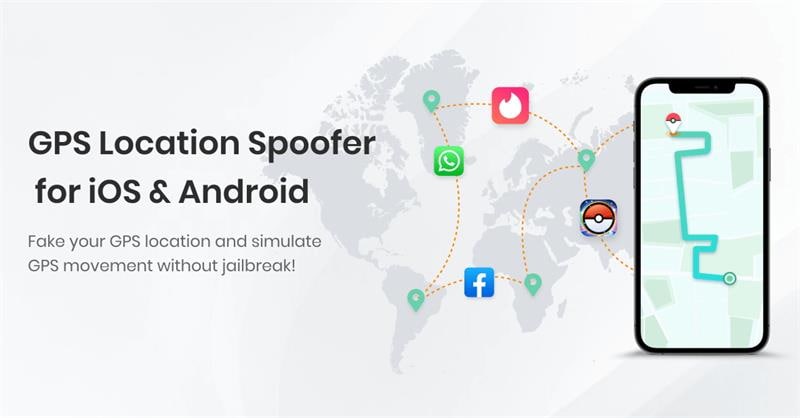
Key Features:
- You can easily change your device’s GPS location to any place in the world.
- The tool enables you to simulate movement between different locations.
- It allows you to plan and customize specific routes for your simulated movement.
Price: $9.95 per month. $19.95 per quarter.
Pros:
- User-friendly interface.
- Realistic location spoofing.
- Simulated movement options.
Cons:
- Regular updates are required.
- Potential app compatibility issues.
2. iSpoofer Location Spoofer
The iSpoofer Location Spoofer is one of the most effective iOS location spoofers. By quickly shifting iPhone location data to whatever location you wish, you are no longer barred from enjoying location-based games and accessing content from different locations.

Key features:
- By tapping on the marks on the map, you may plan and personalize your journeys.
- Once you’ve picked the play button, you can automatically travel between locations.
- The movement speed can be changed.
Price: $4.95 monthly, $12.95 per quarter.
Pros:
- Users can load a GPX file.
- Spoofing location on multiple devices at the same time.
- There are three spoofing modes available.
Cons:
- Some games may not allow you to use it for fake locales.
- It costs a hefty amount.
- You’ll need a Developer Image File and iTunes installed on your phone to operate.
 Glarysoft File Recovery Pro - Helps to recover your lost file/data, even permanently deleted data.
Glarysoft File Recovery Pro - Helps to recover your lost file/data, even permanently deleted data.
3. iTools Location changer
ThinkSky’s iTools is a phone GPS location program. It’s a desktop app that can let you spoof your iPhone’s location. It is compatible with both Windows and macOS. In addition, you don’t need any technical knowledge to modify the location as it offers a user-friendly UI.

Key features:
- Quickly change the GPS location.
- You can control the speed of movement.
- It features a full-screen map.
Price: Bundle sales. There is no set price.
Pros:
- You get a joystick for easy navigation.
- It doesn’t mandate installing iTunes.
- Jailbreaking is not required.
Cons:
- Set up time is nearly 25 minutes, which is longer than Dr.Fone.
- Not support iPhone 13, 12, and 11, iOS 13 and above.
- It may be hard to use for some new users.
4. Fake GPS Location Tool
Link: https://apps.apple.com/us/app/fake-gps-location-tool/id1133848135
You can travel across the world with this Fake GPS Location app. To mock your location, search for a certain address in your app’s complete address or merely city, state, country, or famous sites.

Key features:
- This allows you to take a screenshot of your new location.
- Friendly user interface.
- Move your location automatically.
Price: $2.99.
Pros:
- Change the location by typing.
- Safety guaranteed.
- The price is not that high starting from 2.99 US dollars.
Cons:
- The pointer does not allow for precise location selection.
- It is not safe to use for some games, unlike Dr.Fone.
5. iTeleporter Location Spoofer
Link: https://www.virtuallocation.com/iteleporter.html
This is a hardware technique for mocking your iPhone’s location. There are several versions of the dongle. Using this location spoofer, you can easily enjoy games and social media without any worry**.**
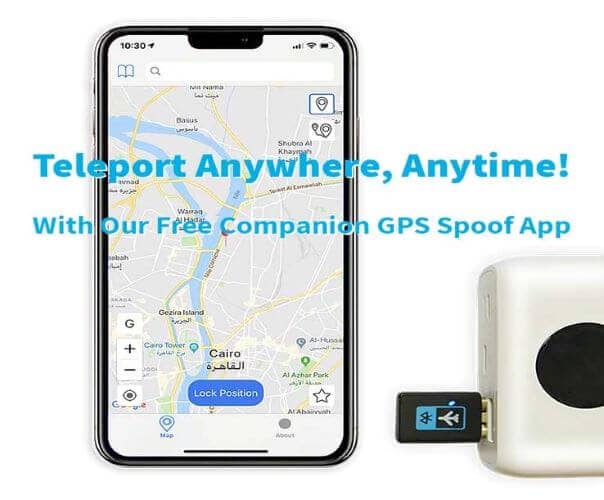
Key features:
- The location spoofer is simple to use and works with most iPhone models.
- Enter the location’s name or coordinates into the program to fake your location.
- Setting up a path and replicating the Vivo X Fold 2 device’s movement is also an option.
Price: $228 for each dongle.
Pros:
- A user-friendly application allows easy spoofing of device location.
- It Supports changing location on some social and dating apps.
Cons:
- Comes with a dongle.
- The use of steps is not easy.
Tips: Join the ranks of the best! Dr.Fone - Virtual Location is the best location changers for Android and iOS. Experience seamless and accurate location changes on your devices. Unlock a world of possibilities with Dr.Fone - Virtual Location today! Try it now!
Top 5 Location Changers for Android
1. GPS Emulator
Link: https://play.google.com/store/apps/details?id=com.rosteam.gpsemulator
A simple way to modify your Vivo X Fold 2’s location so you can use it for dating apps and services to meet more people! After installing the app, choose a place to use as your device’s default location.

Key features:
- It offers three types of maps: normal, satellite, and terrain.
- Helping change location and altitude easily.
- Strong map search engine.
Pros:
- Useful for playing AR games.
- Free to use.
Cons:
- Reset the location in 2 minutes.
- May lag when you send your fake location to others.
2. Fake GPS Location - GPS JoyStick
Link: https://play.google.com/store/apps/details?id=com.theappninjas.fakegpsjoystick&hl=en\_US
It is one of the most popular Android smartphone location spoofing apps that you can try. The App Ninjas created the location spoofer, which is freely downloadable. Like Dr.Fone, you can easily change your location on Android without rooting your phone with this tool.

Key features:
- You can point to any spot or specify its coordinates directly.
- You can choose from various modes (such as walking, jogging, or running) and set your favorite speed.
- The free fake location spoofer does not require root access and works on Android 4.4 and up.
Pros:
- It includes a GPS joystick, which helps perform the “Pokemon Go Walking” hack.
- You can create and save the routines you like.
Cons:
- Random problems and app crash.
- Pokemon Go occasionally fails to recognize the location specified in the app.
- Interface fulfills ads. If you want a straightforward interface, Dr.Fone is a good choice.
3. Fake GPS location - Lexa
Link: https://play.google.com/store/apps/details?id=com.lexa.fakegps
One of the most popular Android spoofing apps is Lexa’s Fake GPS. It allows you to alter your phone’s location and enjoy Pokemon Go from wherever you are. Using fake GPS, visit all of your favorite poke stops worldwide.

Key features:
- Fake location on any Android phone with root.
- Supporting fake locations to play geo-based games.
Pros:
- More than 280,000 users have given FakeGPS a 4.6-star rating on the Google Play Store. It’s a reliable Pokemon Go fake app for Android.
- Free download and easy to use.
Cons:
- For a few gadget owners, fake GPS may feel a little problematic.
- After you deactivate the program, your GPS location may become trapped in one spot.
4. VPNa - Fake GPS Location
Link: https://play.google.com/store/apps/details?id=com.xdoapp.virtualphonenavigation
While the name may be confusing, it is a GPS spoofer for Android, not a VPN. The regular version is free to download and works with Android 4.4 and more.

Key features:
- You do not have to root your device to use this free false location spoofing app.
- You can also set preferred areas with the GPS location faker to easily modify your location.
Pros:
- You can input the target location’s coordinates or address manually.
- With just one tap, it allows you to use the “Pokemon Go Walking” trick.
Cons:
- Obtrusive advertisements.
- There’s no joystick option.
5. Fake GPS 360
Link: https://play.google.com/store/apps/details?id=com.pe.fakegps
This is an all-in-one solution for all your device location-altering needs. With this software installed on your phone, you may instantly change your phone’s system location to any new location you desire. This tricks your social networking and other apps into thinking you’ve moved.
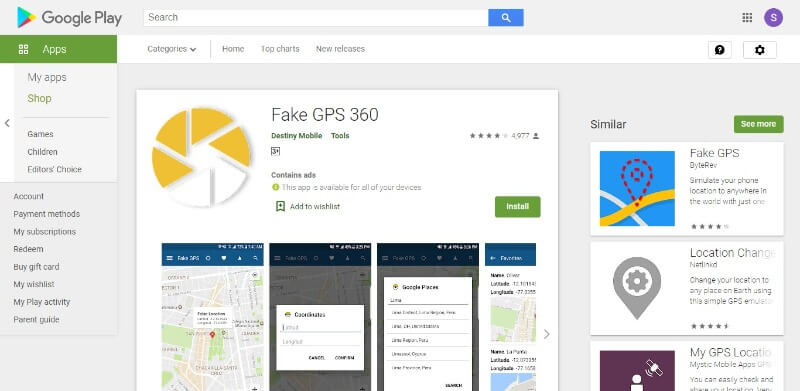
Key features:
- There are several options for selecting a new GPS location.
- Save locations for later.
Pros:
- GPS precision customized.
- You can save the routines.
Cons:
- Certain apps do not appear to function correctly with this app.
- The app may crash sometimes.
Conclusion
Mock location applications for iOS and Android come helpful in various situations. Using a competent imitation location app can assist you in doing the task swiftly and efficiently. The spoof location and GPS apps listed here are safe to use. If you want a one-stop way to fake your location on Android and iOS devices, then Dr.Fone - Virtual Location is the best choice.
Dr.Fone - Virtual Location
1-Click Location Changer for both iOS and Android
- Teleport from one location to another across the world from the comfort of your home.
- With just a few selections on your computer, you can make members of your circle believe you’re anywhere you want.
- Stimulate and imitate movement and set the speed and stops you take along the way.
- Compatible with both iOS and Android systems.
- Work with location-based apps, like Pokemon Go , Snapchat , Instagram , Facebook , etc.
3981454 people have downloaded it
- Title: Is pgsharp legal when you are playing pokemon On Vivo X Fold 2? | Dr.fone
- Author: Ava
- Created at : 2024-08-01 19:56:06
- Updated at : 2024-08-02 19:56:06
- Link: https://fake-location.techidaily.com/is-pgsharp-legal-when-you-are-playing-pokemon-on-vivo-x-fold-2-drfone-by-drfone-virtual-android/
- License: This work is licensed under CC BY-NC-SA 4.0.
 Greeting Card Builder
Greeting Card Builder Any DRM Removal for Win:Remove DRM from Adobe, Kindle, Sony eReader, Kobo, etc, read your ebooks anywhere.
Any DRM Removal for Win:Remove DRM from Adobe, Kindle, Sony eReader, Kobo, etc, read your ebooks anywhere. EaseText Audio to Text Converter for Windows (Personal Edition) - An intelligent tool to transcribe & convert audio to text freely
EaseText Audio to Text Converter for Windows (Personal Edition) - An intelligent tool to transcribe & convert audio to text freely 





 PCDJ Karaoki is the complete professional karaoke software designed for KJs and karaoke venues. Karaoki includes an advanced automatic singer rotation list with singer history, key control, news ticker, next singers screen, a song book exporter and printer, a jukebox background music player and many other features designed so you can host karaoke shows faster and easier!
PCDJ Karaoki is the complete professional karaoke software designed for KJs and karaoke venues. Karaoki includes an advanced automatic singer rotation list with singer history, key control, news ticker, next singers screen, a song book exporter and printer, a jukebox background music player and many other features designed so you can host karaoke shows faster and easier!